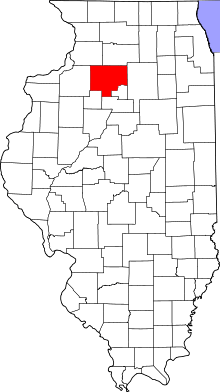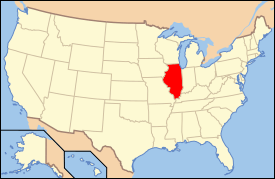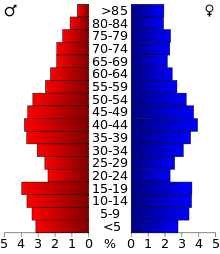Bureau County, Illinois
| Bureau County, Illinois | |
|---|---|
 Red Covered Bridge (1863) | |
 Location in the U.S. state of Illinois | |
 Illinois's location in the U.S. | |
| Founded | 1837 |
| Seat | Princeton |
| Largest city | Princeton |
| Area | |
| • Total | 874 sq mi (2,264 km2) |
| • Land | 869 sq mi (2,251 km2) |
| • Water | 4.5 sq mi (12 km2), 0.5% |
| Population | |
| • (2010) | 34,978 |
| • Density | 40/sq mi (20/km2) |
| Congressional district | 16th |
| Time zone | Central: UTC−6/−5 |
| Website |
bureaucounty-il |
Bureau County is a county located in the U.S. state of Illinois. As of the 2010 census, the population was 34,978.[1] Its county seat is Princeton.[2]
Bureau County is part of the Ottawa–Peru, IL Micropolitan Statistical Area, which the Hennepin Canal Parkway State Park is located partly in this county.
History
Bureau County was created out of Putnam County in 1837. It is named for either Michel or Pierre Bureau, French Canadian brothers who ran a trading post from 1776 until the 1780s near where Big Bureau Creek joins the Illinois River. Their actual surname most likely was Belleau, but the local American Indians had difficulty pronouncing the "l" sound, which was not found in some local languages.[3][4]
An early settler of this area was Bulbona, a man of mixed French and Native American descent with a Native American wife. Unlike most of the other Native Americans in the area, Bulbona remained after the area was settled by Euro-Americans and ran a trading post where he sold whiskey.[5]
The founders of Princeton, the oldest town in the county consisted entirely of settlers from New England. They were descendants of the English Puritans who settled New England in the 17th century. They were part of a wave of New England farmers who moved to the Northwest Territory in the early 19th century. Most of them came soon after of the completion of the Erie Canal.[6] When they arrived in what is now Bureau County there was nothing but a virgin forest and wild prairie, the New Englanders laid out farms, constructed roads, erected government buildings and established post routes. They brought with them many of their Yankee New England values, such as a passion for education, establishing many schools as well as staunch support for abolitionism. They were mostly members of the Congregationalist Church though some were Episcopalian. Historically, Bureau County, like much of northern Illinois, was culturally very continuous with early New England culture.[7][8][9]
Like so many other areas in the Midwest, this county was on a "line" of the Underground Railroad. There was a "station" at the home of Owen Lovejoy in Princeton, as well as several other locations throughout the county.
 Bureau County's boundaries have remained unchanged since its creation in 1837
Bureau County's boundaries have remained unchanged since its creation in 1837
Geography
According to the U.S. Census Bureau, the county has a total area of 874 square miles (2,260 km2), of which 869 square miles (2,250 km2) is land and 4.5 square miles (12 km2) (0.5%) is water.[10] Big Bureau Creek is the main body of water.
Adjacent counties
- Lee County - north
- Putnam County - southeast
- LaSalle County - east
- Marshall County - south
- Stark County - southwest
- Henry County - west
- Whiteside County - northwest
Major highways
Climate and weather
| Princeton, Illinois | ||||||||||||||||||||||||||||||||||||||||||||||||||||||||||||
|---|---|---|---|---|---|---|---|---|---|---|---|---|---|---|---|---|---|---|---|---|---|---|---|---|---|---|---|---|---|---|---|---|---|---|---|---|---|---|---|---|---|---|---|---|---|---|---|---|---|---|---|---|---|---|---|---|---|---|---|---|
| Climate chart (explanation) | ||||||||||||||||||||||||||||||||||||||||||||||||||||||||||||
| ||||||||||||||||||||||||||||||||||||||||||||||||||||||||||||
| ||||||||||||||||||||||||||||||||||||||||||||||||||||||||||||
In recent years, average temperatures in the county seat of Princeton have ranged from a low of 14 °F (−10 °C) in January to a high of 85 °F (29 °C) in July, although a record low of −22 °F (−30 °C) was recorded in February 1996 and a record high of 102 °F (39 °C) was recorded in June 1988. Average monthly precipitation ranged from 1.48 inches (38 mm) in February to 4.76 inches (121 mm) in August.[11]
Demographics

| Historical population | |||
|---|---|---|---|
| Census | Pop. | %± | |
| 1840 | 3,067 | — | |
| 1850 | 8,841 | 188.3% | |
| 1860 | 26,426 | 198.9% | |
| 1870 | 32,415 | 22.7% | |
| 1880 | 33,172 | 2.3% | |
| 1890 | 35,014 | 5.6% | |
| 1900 | 41,112 | 17.4% | |
| 1910 | 43,975 | 7.0% | |
| 1920 | 42,648 | −3.0% | |
| 1930 | 38,845 | −8.9% | |
| 1940 | 37,600 | −3.2% | |
| 1950 | 37,711 | 0.3% | |
| 1960 | 37,594 | −0.3% | |
| 1970 | 38,541 | 2.5% | |
| 1980 | 39,114 | 1.5% | |
| 1990 | 35,688 | −8.8% | |
| 2000 | 35,503 | −0.5% | |
| 2010 | 34,978 | −1.5% | |
| Est. 2016 | 33,359 | [12] | −4.6% |
| U.S. Decennial Census[13] 1790-1960[14] 1900-1990[15] 1990-2000[16] 2010-2013[1] | |||
As of the 2010 United States Census, there were 34,978 people, 14,262 households, and 9,605 families residing in the county.[17] The population density was 40.2 inhabitants per square mile (15.5/km2). There were 15,720 housing units at an average density of 18.1 per square mile (7.0/km2).[10] The racial makeup of the county was 94.2% white, 0.7% Asian, 0.6% black or African American, 0.3% American Indian, 3.0% from other races, and 1.3% from two or more races. Those of Hispanic or Latino origin made up 7.7% of the population.[17] In terms of ancestry, 32.8% were German, 13.8% were Irish, 12.1% were English, 9.2% were American, 8.8% were Italian, 7.6% were Swedish, and 5.8% were Polish.[18]
Of the 14,262 households, 29.8% had children under the age of 18 living with them, 53.6% were married couples living together, 9.2% had a female householder with no husband present, 32.7% were non-families, and 28.0% of all households were made up of individuals. The average household size was 2.42 and the average family size was 2.94. The median age was 42.5 years.[17]
The median income for a household in the county was $45,692 and the median income for a family was $55,217. Males had a median income of $42,327 versus $29,210 for females. The per capita income for the county was $24,103. About 8.6% of families and 11.1% of the population were below the poverty line, including 15.3% of those under age 18 and 7.5% of those age 65 or over.[19]
Communities
Cities
Villages
Unincorporated community
- Kasbeer
- Love, Illinois
Townships
Bureau County is divided into these twenty-five townships:
Notable people
- Charles W. Brooks, U.S. Senator
- Warren Giles, executive in Baseball Hall of Fame
- Virgil Fox, concert organist
- Kathryn Hays, actress
- Robert Petkoff, actor
- Eliza Suggs, author and temperance activist
- Richard Widmark, actor
Politics
| Year | Republican | Democratic | Third Parties |
|---|---|---|---|
| 2016 | 56.0% 9,281 | 36.4% 6,029 | 7.6% 1,261 |
| 2012 | 48.9% 8,164 | 48.8% 8,134 | 2.3% 388 |
| 2008 | 46.1% 7,911 | 51.8% 8,889 | 2.1% 353 |
| 2004 | 54.9% 9,822 | 44.5% 7,961 | 0.7% 119 |
| 2000 | 50.7% 8,526 | 46.1% 7,754 | 3.2% 543 |
| 1996 | 40.6% 6,528 | 47.6% 7,651 | 11.8% 1,894 |
| 1992 | 38.2% 6,836 | 42.2% 7,551 | 19.7% 3,520 |
| 1988 | 54.4% 8,896 | 45.0% 7,354 | 0.6% 101 |
| 1984 | 62.6% 11,741 | 36.9% 6,925 | 0.5% 99 |
| 1980 | 61.8% 11,484 | 31.0% 5,753 | 7.3% 1,350 |
| 1976 | 58.2% 10,854 | 40.6% 7,566 | 1.2% 228 |
| 1972 | 67.5% 12,786 | 32.4% 6,133 | 0.2% 33 |
| 1968 | 60.0% 11,216 | 33.7% 6,304 | 6.3% 1,183 |
| 1964 | 51.3% 9,552 | 48.8% 9,086 | 0.0% 0 |
| 1960 | 61.7% 12,597 | 38.2% 7,786 | 0.1% 24 |
| 1956 | 70.6% 13,909 | 29.3% 5,781 | 0.1% 21 |
| 1952 | 69.8% 14,300 | 30.1% 6,173 | 0.1% 25 |
| 1948 | 63.2% 11,207 | 36.4% 6,463 | 0.4% 78 |
| 1944 | 62.7% 11,802 | 37.1% 6,976 | 0.3% 51 |
| 1940 | 61.4% 13,258 | 38.3% 8,274 | 0.4% 75 |
| 1936 | 51.5% 10,462 | 46.8% 9,516 | 1.7% 344 |
| 1932 | 45.2% 8,721 | 53.5% 10,309 | 1.3% 250 |
| 1928 | 63.7% 11,557 | 35.8% 6,486 | 0.5% 90 |
| 1924 | 60.4% 9,457 | 12.7% 1,995 | 26.9% 4,211 |
| 1920 | 74.9% 9,968 | 17.7% 2,354 | 7.4% 980 |
| 1916 | 56.2% 8,213 | 39.6% 5,793 | 4.2% 608 |
| 1912 | 19.8% 1,816 | 30.6% 2,800 | 49.6% 4,537 |
| 1908 | 57.5% 5,280 | 31.3% 2,871 | 11.3% 1,035 |
| 1904 | 64.3% 5,624 | 21.9% 1,917 | 13.8% 1,204 |
| 1900 | 56.9% 5,478 | 36.6% 3,523 | 6.5% 626 |
| 1896 | 56.3% 5,474 | 40.7% 3,961 | 3.0% 287 |
| 1892 | 48.0% 3,924 | 43.5% 3,555 | 8.6% 702 |
As part of Yankee-settled Northern Illinois, Bureau County became powerfully Republican for the century following the Civil War. The only Democrat to carry the county between 1856 and 1988 was Franklin D. Roosevelt during his landslide 1932 victory, although Progressive Theodore Roosevelt did carry the county during the 1912 election when the GOP was mortally divided. Between 1988 and 2012, the county trended Democratic – Bill Clinton won pluralities in both his elections and Barack Obama won an absolute majority in 2008 and nearly did so in 2012 – however concern with lack of employment opportunities in the Rust Belt led to a powerful swing toward Donald Trump in 2016 for the best GOP result since Ronald Reagan’s 1984 landslide.
See also
References
- Specific
- 1 2 "State & County QuickFacts". United States Census Bureau. Archived from the original on July 6, 2011. Retrieved July 3, 2014.
- ↑ "Find a County". National Association of Counties. Archived from the original on 2011-05-31. Retrieved 2011-06-07.
- ↑ Pierre de Beuro, an Indian trader Pioneers of Illinois by Nehemiah Matson, 1882, p. 229
- ↑ Jean Baptiste Point de Sable : the founder of modern Chicago Archived 2012-09-10 at WebCite by John F. Swenson, 1999- . Retrieved 11 November 2010.
- ↑ Bradsby, H. C. (Henry C. ) (11 May 1885). "History of Bureau County, Illinois". Chicago : World Pub. Co. Archived from the original on 31 January 2010 – via Internet Archive.
- ↑ Henry C. Bradsby (1885). History of Bureau County, Illinois. Unigraphic. pp. 246–.
- ↑ Nehemiah Matson (1872). Reminiscences of Bureau County [Illinois] in Two Parts. Republican book and job office. pp. 265–.
- ↑ Harrington, George B. (11 May 2018). "Past and Present of Bureau County, Illinois: Together with Biographical Sketches of Many of Its Prominent and Leading Citizens and Illustrious Dead". Pioneer Publishing Company – via Google Books.
- ↑ Bradsby, Henry C. (11 May 1885). "History of Bureau County, Illinois". Unigraphic – via Google Books.
- 1 2 "Population, Housing Units, Area, and Density: 2010 - County". United States Census Bureau. Retrieved 2015-07-11.
- 1 2 "Monthly Averages for Princeton, Illinois". The Weather Channel. Archived from the original on 2012-09-10. Retrieved 2011-01-27.
- ↑ "Population and Housing Unit Estimates". Archived from the original on May 29, 2017. Retrieved June 9, 2017.
- ↑ "U.S. Decennial Census". United States Census Bureau. Archived from the original on May 12, 2015. Retrieved July 3, 2014.
- ↑ "Historical Census Browser". University of Virginia Library. Archived from the original on August 16, 2012. Retrieved July 3, 2014.
- ↑ "Population of Counties by Decennial Census: 1900 to 1990". United States Census Bureau. Archived from the original on April 24, 2014. Retrieved July 3, 2014.
- ↑ "Census 2000 PHC-T-4. Ranking Tables for Counties: 1990 and 2000" (PDF). United States Census Bureau. Archived (PDF) from the original on December 18, 2014. Retrieved July 3, 2014.
- 1 2 3 "DP-1 Profile of General Population and Housing Characteristics: 2010 Demographic Profile Data". United States Census Bureau. Retrieved 2015-07-11.
- ↑ "DP02 SELECTED SOCIAL CHARACTERISTICS IN THE UNITED STATES – 2006-2010 American Community Survey 5-Year Estimates". United States Census Bureau. Retrieved 2015-07-11.
- ↑ "DP03 SELECTED ECONOMIC CHARACTERISTICS – 2006-2010 American Community Survey 5-Year Estimates". United States Census Bureau. Retrieved 2015-07-11.
- ↑ Leip, David. "Dave Leip's Atlas of U.S. Presidential Elections". uselectionatlas.org. Archived from the original on 2018-03-23.
- General
External links
| Wikimedia Commons has media related to Bureau County, Illinois. |
